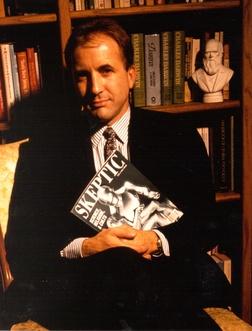Books and Arts; Book Review;The power of faith;Irrational belief;
文藝;書評;信仰的力量;非理性信仰;
The Believing Brain: From Ghosts and Gods to Politics and Conspiracies—How We Construct Beliefs and Reinforce Them as Truths. By Michael Shermer.
《有信仰者》:從鬼神到政治陰謀——我們是怎樣形成信念并固以視之為真理。——麥可·薛默著。

Michael Shermer is a psychologist, cyclist, one-time fundamentalist Christian, founder of Skeptic magazine and, currently, the author of a monthly column with the same name published in Scientific American. He has built a professional career out of casting a rationalist's eye over some of the wackiest beliefs that humanity has to offer.
麥可·薛默(Michael Shermer)是一位心理學家和騎自行車愛好者,曾經一度是基督教原教旨主義者、《懷疑論者》雜志的創始人,而現在是《科學美國人》中與其同名的每月專欄的作家。他已成就了他的職業生涯,因為他以理性的眼光審視人們情不自禁流露出來的某些極為荒謬的信念。
But his latest book is more than just a display case full of specimens collected by a man fascinated by the paranormal. Mr Shermer is interested in how such beliefs come to be held, and why they can persist even in the face of what, to others, can seem to be the overwhelming evidence that contradicts them.
然而他的最新著作不僅僅是裝滿了著迷于超自然的他所收集案例的展示柜。而且薛默先生還展示了他感興趣的是人們是怎么懷有這樣的信念以及為什么他們在面對似乎有壓倒性證據去反駁他們時還固執己見。
The first part of the book is a mixture of psychology and trendy neuroscience research that presents the evidence for Mr Shermer's central claim: that, instead of shaping belief around painstakingly gathered, soberly judged evidence, people most often decide upon their beliefs first, and then use an impressive range of cognitive tricks to bend whatever evidence they do discover into support for those pre-decided acts of faith.
該書的第一部分是心理學和盛行的神經科學研究的大雜燴,提供了證明薛默先生主要觀點的證據:也就是,四處煞費苦心收集來的成形信仰和冷靜判斷的依據。人們很多時候首先決定自己的信念,然后,無論他們所發現證據是否去支撐他們以前決定的信仰行為,他們也利用一些令人印象深刻的認知騙局去扭曲事實。
In the second part of “The Believing Brain” Mr Shermer applies those observations to the almost infinite variety of weird and wonderful beliefs that people hold, from alien abductions to government conspiracies to bring down the World Trade Centre—and, inevitably, to religion (a chapter on politics, by contrast, feels misplaced and forced). He is an able skewerer of sloppy thinking. The section on conspiracy theories, for instance, memorably exposes the bizarre leaps of logic that adherents often make: “If I cannot explain every single minutia [about the collapse of the twin towers]…that lack of knowledge equates to direct proof that 9/11 was orchestrated by Bush, Cheney, Rumsfeld and the CIA.”
在《有信仰者》第二部分,薛默先生引用了這些對人們所懷有的幾乎所有怪異信仰的觀察結果,從外星人綁架到炸毀世界貿易中心的政府陰謀,不可避免地也談及到宗教(相比之下,政治這一章讓人感覺有點錯位和牽強)。他是一個能干的凌亂思維整理者。例如, 關于陰謀論部分,明顯出現邏輯思維的斷層:信徒們常常認為“如果我不能解釋出[關于雙子塔倒塌]的每一細節... ...這認識的缺失相當于直接證明9/11是布什、切尼、倫斯斐和中央情報局精心安排的。
A common risk with this kind of book is that the author comes across as overly smug and superior; just look at how the duke of debunkers, Richard Dawkins, is sometimes perceived, even by his fans. Mr Shermer is aware of this risk, and is at pains to reassure readers that his conclusions apply to everyone, even himself. In a chapter on alien abductions, he recounts an abduction story of his own. Exhausted after cycling 1,259 miles in 83 hours as part of an endurance challenge called the Race Across America, he becomes convinced that the motorhome carrying his support team is actually an alien spacecraft, and that his team's pleas for him to come inside and get some rest are merely a cunning pretext to get him to co-operate with a spot of alien probing. Surprised when the interior of the mothership turns out to closely resemble a General Motors motorhome, Mr Shermer consents to lying down. On waking a couple of hours later, he is able to joke about the experience with his team-mates.
這類書籍的常見風險是,作者看上去好像過于自以為是和過于嘩眾取寵;只要看看揭露真面目者的公爵理查德·道金斯有時給人的感覺就明白了,甚至連他的粉絲也有這種感覺。薛默先生是意識到這種風險,并煞費心思地使認為“作者的結論適用于每個人,甚至他自己”的讀者安心下來。在關于外星人綁架那章中,他講述了他自己的綁架故事。經過被他稱為戰橫穿美國的長征的83小時1259英里的騎行耐力挑戰后,他筋疲力盡。他開始相信,裝載著他支持的球隊的房車實際上是一艘外星飛船,他的球隊那讓他進去歇歇的請求僅僅是一個狡猾的借口好讓他與之合作一起探索外星船。當他發現母艦內部酷似通用汽車房車,薛默先生十分驚訝并同意躺下歇會。他在兩個小時后醒來,他還能拿這經歷來和隊友們開玩笑。
That experience gives one useful definition of a sceptic, as Mr Shermer understands the term: one who is aware of the fallibility of intuitions, and willing to take steps to minimise them. It remains, sadly, an uncommon combination.
這經驗給出了懷疑論者的很好的定義,正如薛默先生理解術這語一樣:一人意識到直覺的不可靠性,并樂意采取措施盡量減少直覺的偏差。可惜,這仍是一種不尋常的組合。












